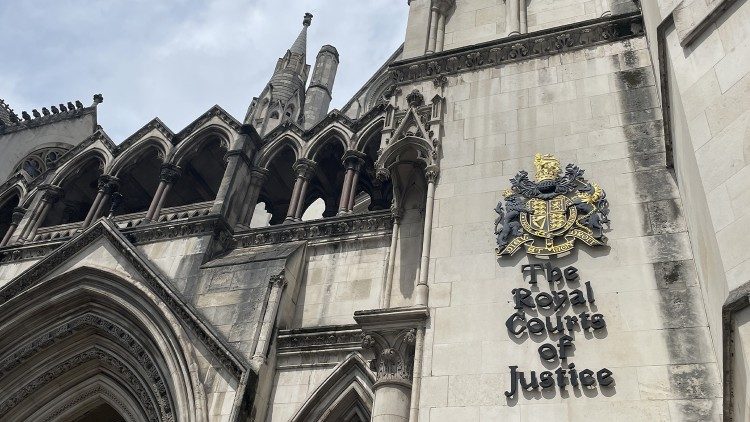The final portion of the Substitute for the Secretary of State’s testimony at the Royal Courts of Justice in the ongoing civil case on the Sloane Avenue property purchase.
The Holy See was a “victim of serious fraud” in the purchase of the London property.
Monsignor Edgar Peña Parra, the Substitute for the Secretariat of State, reiterated this point three times during his third and final interrogation at the Royal Courts of Justice in London.
This session was part of the ongoing civil trial concerning the Sloane Avenue property, set to continue until July 18.
The hearing was marked by a more tense atmosphere compared to previous sessions, with occasional heated exchanges, particularly from Charles Samek, the lawyer defending financier Raffaele Mincione.
Mincione, who was sentenced in the first instance by the Vatican Tribunal in December 2023, initiated the case four years ago to demonstrate his “good faith” in negotiations with the Secretariat of State.
Accusations
Mincione’s name surfaced only an hour and a half into the session.
As in the hearings on July 5 and 6, transactions with broker Gianluigi Torzi, particularly the payment of 15 million euros by the Holy See to regain control of a property, dominated Samek’s questions.
At the end of the hearing, Samek listed 20 propositions contrary to the Holy See’s positions, which Peña Parra vehemently denied.
One accusation was that Peña Parra had provided the Pope with partial and inconsistent information in a memo that referenced, among other things, the London affair.
The Memorandum to the Pope
A document produced at the start of the hearing by the Holy See’s defense lawyer, Samar Abbas Kazmi, countered this claim.
It was a “note” dated May 2, 2019, in which Peña Parra, who had taken on his new role seven months prior, outlined the entire London affair to the Pope. This included the payment to Torzi, certified by invoices indicating services not actually rendered after Torzi applied pressure.
Torzi had threatened to resell the building, as evidenced by a “brochure” received by the Secretariat of State a week before the final stage of the transaction, openly stating the building was intended for sale.
Omissions and Lies
“Mr. Torzi wanted to do only what he wanted,” said Peña Parra.
He leveraged his control through a share purchase agreement signed in his London office in November 2018, in the presence of two Secretariat of State officials.
This agreement was signed “without authorization” by then-head of the Administrative Office, Monsignor Alberto Perlasca, and ratified by Peña Parra based on assurances from Nicola Squillace, presented as “our lawyer” (also convicted in the first instance).
“He sent me a monument of lies,” Peña Parra said.
Torzi, after sending a false invoice for supposed property management services, had minimal contact with the Holy See. Peña Parra emphasized that Torzi had behaved similarly before, recalling an incident in his office where Torzi had removed Fabrizio Tirabassi, an ex-official of the Administrative Office (also convicted), from the board of the Gutt fund.
Negotiations with Torzi
Samek argued that there was an agreement with Torzi.
“Months were spent negotiating with someone suspected of fraud,” he said, referencing the 15 million euros paid to Torzi when only 1 or 2 million euros were initially considered to sever ties with the broker.
According to Samek, the November 2018 framework agreement in London had ended all relations with Mincione and his companies.
He questioned where the alleged “conspiracy” between Torzi and Mincione was, noting that Mincione’s wife continued to use an office in the building managed by Torzi without paying rent.
Chats with Monsignor Carlino
Samek projected and read aloud WhatsApp chats between Torzi and Monsignor Mauro Carlino, then the Substitute’s secretary and the only one acquitted among the ten defendants in the Vatican trial.
Samek claimed these messages showed Carlino was in contact with Torzi about creating a false invoice.
Peña Parra disagreed, stating that Torzi’s persistent responses demonstrated what Vatican judges deemed “extortion.” Torzi intended to list false activities because he had done nothing for the Holy See.
Broker’s Activities
“I disagree with everything. This is your version,” Peña Parra stated. “We rejected that invoice and the activities Torzi claimed to have done for us, which is why I clearly told my team that my letter was not an invoice. I did not lie.”
He emphasized that his instruction to Credit Suisse for a 5 million euro transfer was a “full and final settlement of all our contractual obligations.”
However, attachments to this email to Credit Suisse mentioned other reasons, including services rendered by Torzi for properties in other cities.
The Substitute’s Role
“I am certainly responsible for what I have done, but I have a team” responsible for distributing pre-discussed and approved documents, Peña Parra explained, with a touch of irony: “Yes, usually, I personally send the faxes.”
He highlighted the significance of his role and its demands, countering Samek’s questions that overlooked the Vatican’s workflow.
“I am not responsible for the Administrative Office and every document. I handle major responsibilities.”
Questions and Answers
In a different system from the Italian one, with questions based on dates, numbers, and documents immediately displayed on computers, Peña Parra often began his answers with background to provide context.
“This is not the time for speeches…,” Samek interrupted, accusing him of diverting from the questions.
The judge, Robin Knowles, also urged Samek to ask shorter, more focused questions and not insist on points already addressed or outside the witness’s knowledge, such as the 200 million euros paid to Mincione’s Luxembourg Sicav in 2014. “I was not in the Vatican,” the substitute replied tersely. “I was living a happy life in Mozambique.”
The Vatican News
















